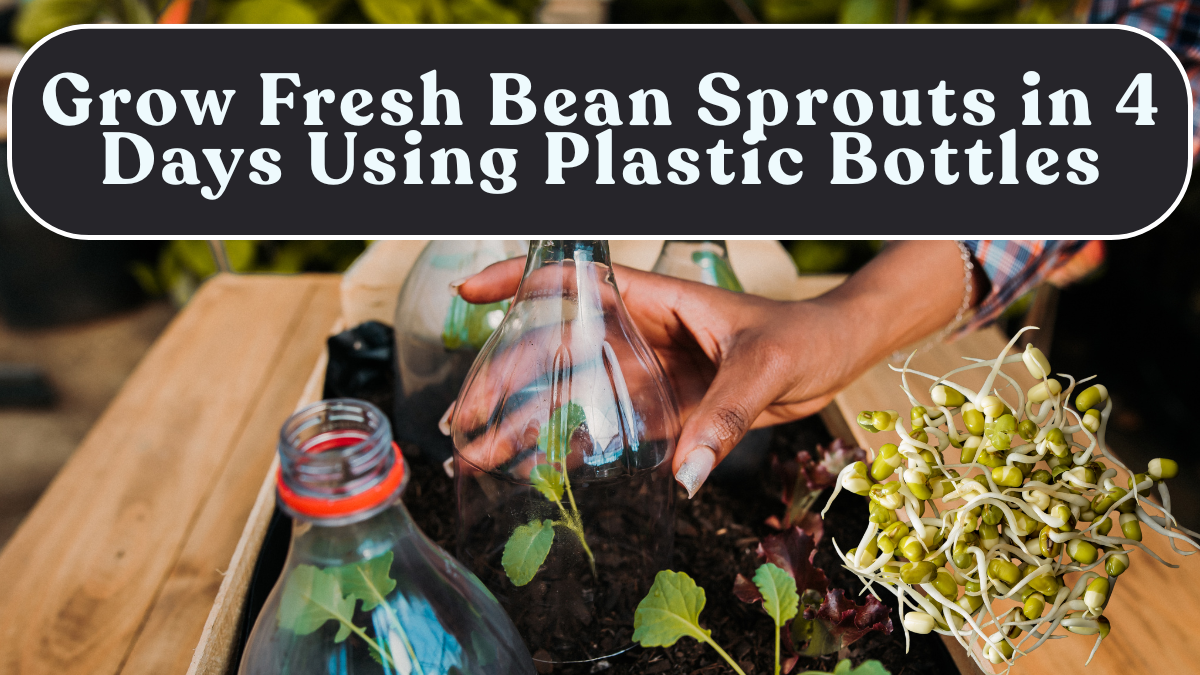If you want to enjoy fresh, crisp, and chemical-free sprouts every morning, this easy guide will teach you how to grow bean sprouts in 4 days using simple plastic bottles. You don’t need soil, fertilizers, or large containers—just clean bottles, water, and patience.
This hydroponic method is one of the most effective and space-saving ways to grow sprouts right in your kitchen, giving you nutritious results in under a week.

Why Sprout Beans at Home?
Homegrown sprouts are fresher, tastier, and safer compared to store-bought versions that often lose nutrients during packaging. Sprouting:
-
Enhances vitamin B, C, and K levels.
-
Improves protein digestibility.
-
Promotes gut health and immunity.
-
Requires almost no investment—just water and time.
It’s also an excellent indoor project for families and children to learn about natural plant growth and healthy eating.
Materials You’ll Need
Here’s everything required to grow sprouts at home:
-
Plastic bottle (1–2 liters, transparent or semi-transparent).
-
Mung beans or soybeans – ideally organic and unpolished.
-
A muslin cloth or fine mesh to cover the bottle opening.
-
Rubber band or string to secure the cloth.
-
Filtered water for rinsing and soaking.
-
A dark, ventilated area like a cupboard or pantry.
This method doesn’t require sunlight or fertilizers—just hygiene and consistency.
Step-by-Step Sprouting Method
1. Soak the Beans
Take about 2 tablespoons of beans and rinse them well. Soak them overnight in a bowl of clean water (8–10 hours). They will double in size by morning.
2. Prepare the Bottle
Cut the top off your plastic bottle for easier handling. Poke a few small holes at the bottom for drainage. Add the soaked beans inside, leaving enough space for air circulation.
3. Cover and Secure
Cover the bottle’s opening with the cloth or mesh and tie it with a rubber band. This allows ventilation while keeping insects and dust away.
4. Rinse and Drain Twice Daily
Fill the bottle with water, shake gently, and drain completely twice a day (morning and evening). Always keep the bottle tilted at an angle to ensure no water stagnates—this prevents bacterial growth.
5. Keep in a Dark Place
Sprouts grow best in darkness as it keeps them white, tender, and crunchy. Store the bottle in a cool, dark corner of your kitchen.
6. Harvest on the 4th Day
By the 4th day, your sprouts will have grown 2–3 inches long. Give them one final rinse and enjoy your fresh, homegrown bean sprouts in salads, sandwiches, or stir-fries.
Tips for Faster Sprouting
-
Maintain room temperature around 22–28°C for optimal growth.
-
If the weather is hot, rinse three times a day to prevent sour odor.
-
Use wide-neck bottles for better airflow and easy rinsing.
-
Don’t expose sprouts to direct sunlight; it hardens them quickly.
These tips ensure consistent, clean, and crunchy sprouts every time.
Health and Culinary Benefits
Homegrown sprouts are not only delicious but also highly nutritious.
They:
-
Boost energy and metabolism.
-
Help with weight management.
-
Improve digestion and skin health.
-
Add a crisp, refreshing texture to meals.
You can use them in noodles, soups, sandwiches, or simply eat them raw with a squeeze of lemon.
Conclusion
Growing bean sprouts in 4 days using plastic bottles is one of the easiest and healthiest DIY gardening ideas. It takes minimal effort and zero cost while delivering fresh, chemical-free nutrition straight to your table.
This method proves that even small steps—like reusing bottles—can lead to sustainable and rewarding results in your daily life.
FAQs
How long does it take to grow bean sprouts at home?
It takes 4 days for mung or soybean sprouts to fully grow using this bottle method.
Do bean sprouts need sunlight?
No, they grow best in dark and cool environments for tender results.
Can I use any type of bottle?
Yes, use any clean plastic bottle with drainage holes and a mesh-covered opening.
How do I prevent foul odor during sprouting?
Rinse the sprouts twice daily and keep the bottle tilted to avoid excess moisture.
Are homemade sprouts safe to eat?
Yes, if grown with filtered water and clean bottles, they are safe, fresh, and nutrient-rich.
